Women Empowered
Sunnie McFadden-Curtis – Creating dialogue of healing for the community
Published
2 years agoon
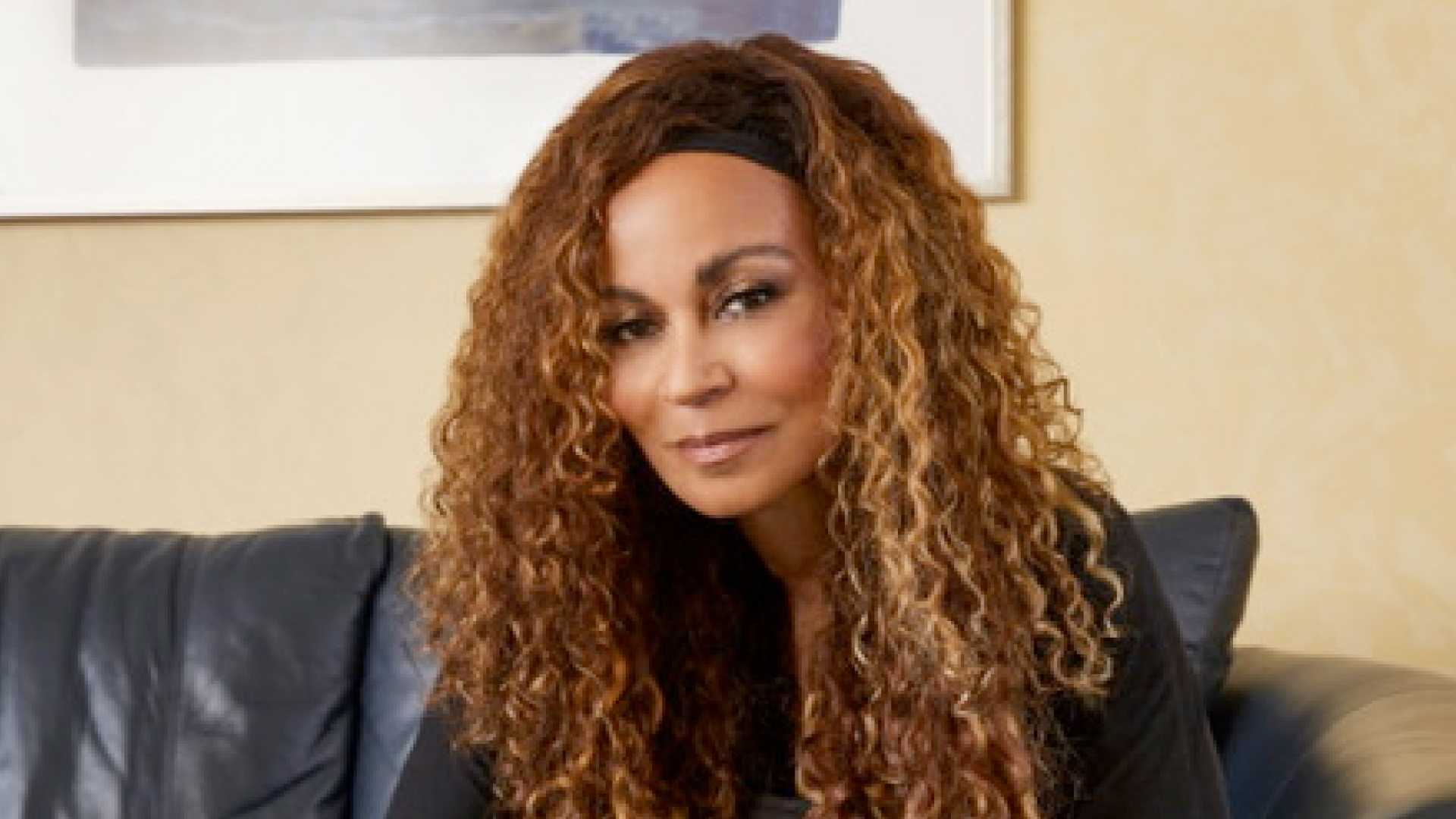
BY SIMONE J. SMITH
“My hope is that Broken Vows: Stories Of Separation, will create a dialogue of healing for its audience members. For those going through a separation themselves—moving through the darkness to the light–I hope they will share this documentary and The Resource as a conversation starter. I also hope they reach out for ’help’ when they need it.” ~ Filmmaker & Social Advocate, Sunnie McFadden-Curtis ~
I was first introduced to this dynamic woman, when I received a press release about her multi-award-winning feature-length documentary BROKEN VOWS: Stories of Separation. This gripping and realistic documentary takes you into the lives of women, their personal stories, and tales of those caught in the crossfire of marriage breakdown and separation.
Anyone who has gone through a separation knows that it can be one of the most psychologically exhausting times in a woman’s life. There is often an expectation to make life-altering decisions under extreme duress. The pandemic has aggravated issues between couples due to: separation, isolation, from family and friends, loss of income, economic instability, disruption of regular routines, and imposed quarantines. This has forced individuals to stay home together, percolating conditions for marital chaos, domestic violence, and separation.
As a lifelong social advocate for women and children, Sunnie decided to take on this topic, and share the stories of women who have experienced BROKEN VOWS. This film follows the socially conscious producer’s previous projects: Bullying: A Culture of Silence, Cyber Bullying: Where Are We Going Wrong? & Shane r u there?
The filmmaker and her son Brennon were honoured to be invited to the United States Senate to take part in roundtable discussions on ways to make schools safer through anti-bullying education, and as a keynote speaker, McFadden-Curtis has also spoken internationally on anti-bullying, providing screenings of her powerful documentary, Bullying: A Culture of Silence.
Last week I had the honour of sitting down with Sunnie for a one-on-one discussion about her life as an actress, advocate and a filmmaker. She began by sharing with me a little bit about her early life.
“I was born and raised in Toronto. My father was from St. Louis and retired in California, My mom was English, Irish, and Scottish heritage. My father was a performer and was performing worldwide. He met my mom in Toronto, and he would come back to visit her whenever he could. It was actually during one of his visits that I was conceived.
Life was very interesting. I was raised in Scarborough by my grandmother (mother’s mother), and it was predominately a White environment. I didn’t know the difference between White and Black. It wasn’t until later that I realized I was Black. I was confused, and I wasn’t in an environment to learn more about my Black heritage. To be honest, it really wasn’t spoken of. I was in High School when I began to learn more about my Black heritage. I would go back and forth between groups, but I wasn’t well received by the Black students. I was more about whom I clicked with. I was bullied because of this.”
Sunnie shares with me that her creative side emerged very young. “I began taking dance lessons when I was six. I invented a toy that was mass-produced (the ballerina swinger). My step grandfather was an inventor. I took a skipping rope after removing the ends, and pulled one end through the hole tide it and then tide the other side big enough to put my foot through it.
“No way!” I exclaimed. “You invented that toy. I remember that toy very well.” I chuckled. “I also remember tripping and busting my lip playing with it.”
“I am so sorry to hear that,” Sunnie said. “I hope that at least you enjoyed playing with it. Okay, where was I? Yes! I was really interested in dancing. I don’t know how good I was, but I loved it. I would choreograph dances, and I would be part of the plays at the school. It was something that inherently I loved.”
She started acting in her mid-twenties, and it wasn’t easy then. There were not a lot of roles for Black girls, but the good thing was that Sunnie was self-motivated.
“I am not a quitter. It would get discouraging at times, but not enough to give up. Back then, you needed six credits to be part of the union, and they brought it down to three to give blacks a fare opportunity to become part of the union. I was modelling during this time, and that was going very well. I would get commercials, but I didn’t get really good roles until later.”
She had done a few movies of the week, and then she landed the role of the lifetime. “Only problem, there was no training for the role, Sunnie tells me. I got a phone call from my agent, and she told me the producer of “All my Children” was starting a show in Toronto. I said to my husband at the time, I am going to get this. I had a chance to visit the studio, and when I got in there and was looking around, something told me that I was going to get that part.
I had a chance to dialogue with the producer and it went really well. Within a week, I was traveling to Nevis (24 hours away), and this is when I found out that I got the part. I had to get back within 48 hours to do press. 48 hours later, I am heading to Antigua, and from there back to Toronto.
Interestingly enough, it was during a press release that Sunnie found out the name of her character.
“So, I was asked what my character’s name was, and I had no idea. I asked one of the writers, and they told me that my character’s name is Sunny. Playing the role of Sunny was difficult at first. During a break in scenes, I had to go back to the dressing room and pep talk myself. This was one of the highlights of my career and I loved it. When I started playing the role, I found out that I was pregnant, but this didn’t stop me. Since then, I have been in and out of acting for most of my life.”
Filmmaking started for Sunnie in 2003. It was part of the social advocacy that she was becoming a part of.
“My son was getting bullied, and as a parent, I was frustrated. I decided that I had to fill the void with education, so I sat down with my son and said, ‘How would you like to do a documentary on bullying?’ He took three days to answer, and he came back and said ‘Yes.’ I ended up taking the lead on the project, and it took me three years to complete it.”
The first film festival she entered the film in was the Reelworld Festival, and it won an award. When she completed the documentary and film festivals, she decided to develop a program and brought it into schools.
“What I loved during my time with students was when I would see the light bulb go off. It meant that something had clicked, and that was the whole point. The program was called “The Ripple Effect!” We looked at how bullying affected everyone involved in their lives. It was recognized by the school board and put in the registry.
I went on that journey for some time and then I began to speak internationally on bullying. It reached 47 cities across North America in universities and libraries.”
“Sunnie, what made you decide to focus on relationships for your current project?”
“Well, BROKEN VOWS: Stories of Separation, spawned from the experiences that my friends were having. Many separations are sequestered in the courts, and this can be extremely painful for those involved. I also went through a separation and had my own experience with it. There was nothing out there like this. I really thought that if I help women subsequently I help their children).
There were moments when I stepped away from the project. I must admit though, I am pretty good at separating myself, and compartmentalizing. The day I had to build my dramatization, I had to live some of what I experienced. I am proud of myself for getting through it. On the second day, I was very conscious not to make people feel uncomfortable, or uncomfortable for me. There were some difficult dramatizations that I had to recreate.
People need to know how to support women during a separation. The film is not just for women even though it is based on women’s stories. There is something in there for everybody.”
Committed to providing hope, McFadden-Curtis has created a digital resource BROKEN VOWS: Stories of Separation “The Resource” to the documentary, which offers real resources that she hopes will help women move forward after separation.
The digital Resource will address the gnawing question: When a marriage ends, where do you begin? BROKEN VOWS: The Resource will be available for purchase at: www.brokenvowsfilm.com The resource can be purchased as individual volumes or in its entirety.
If you want to keep us with Sunnie on social media, you can find her on:
INSTAGRAM: @sunniebiz13
INSTAGRAM: @brokenvowsdocumentary
FACEBOOK: @smcfaddencurtis
FACEBOOK: @brokenvowsfilm
TWITTER: @stopthesilence
We, as humans are guaranteed certain things in life: stressors, taxes, bills and death are the first thoughts that pop to mind. It is not uncommon that many people find a hard time dealing with these daily life stressors, and at times will find themselves losing control over their lives. Simone Jennifer Smith’s great passion is using the gifts that have been given to her, to help educate her clients on how to live meaningful lives. The Hear to Help Team consists of powerfully motivated individuals, who like Simone, see that there is a need in this world; a need for real connection. As the founder and Director of Hear 2 Help, Simone leads a team that goes out into the community day to day, servicing families with their educational, legal and mental health needs.Her dedication shows in her Toronto Caribbean newspaper articles, and in her role as a host on the TCN TV Network.

You may like
-


Step into Spring with SheaMoisture’s new collection
-
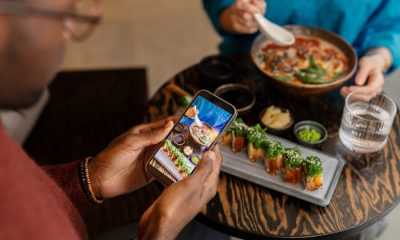

The cost of convenience: how much does delivery really cost?
-
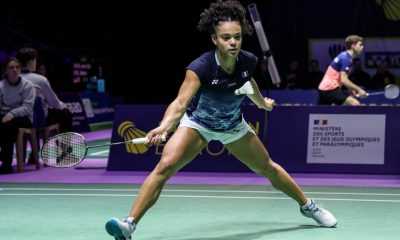

Will Léonice Huet (Black badminton player) qualify for the Paris 2024 Olympics
-


Beneath the waves: Unveiling the legacy of the transatlantic slave trade in the Bahamas
-


Everlasting Flames-to be Submitted
-


Amplifying authentic African narratives; the stars came out at the BSO Symposium
Women Empowered
Chika Ofoha – Helping the community tap into their creativity
Published
1 month agoon
March 25, 2024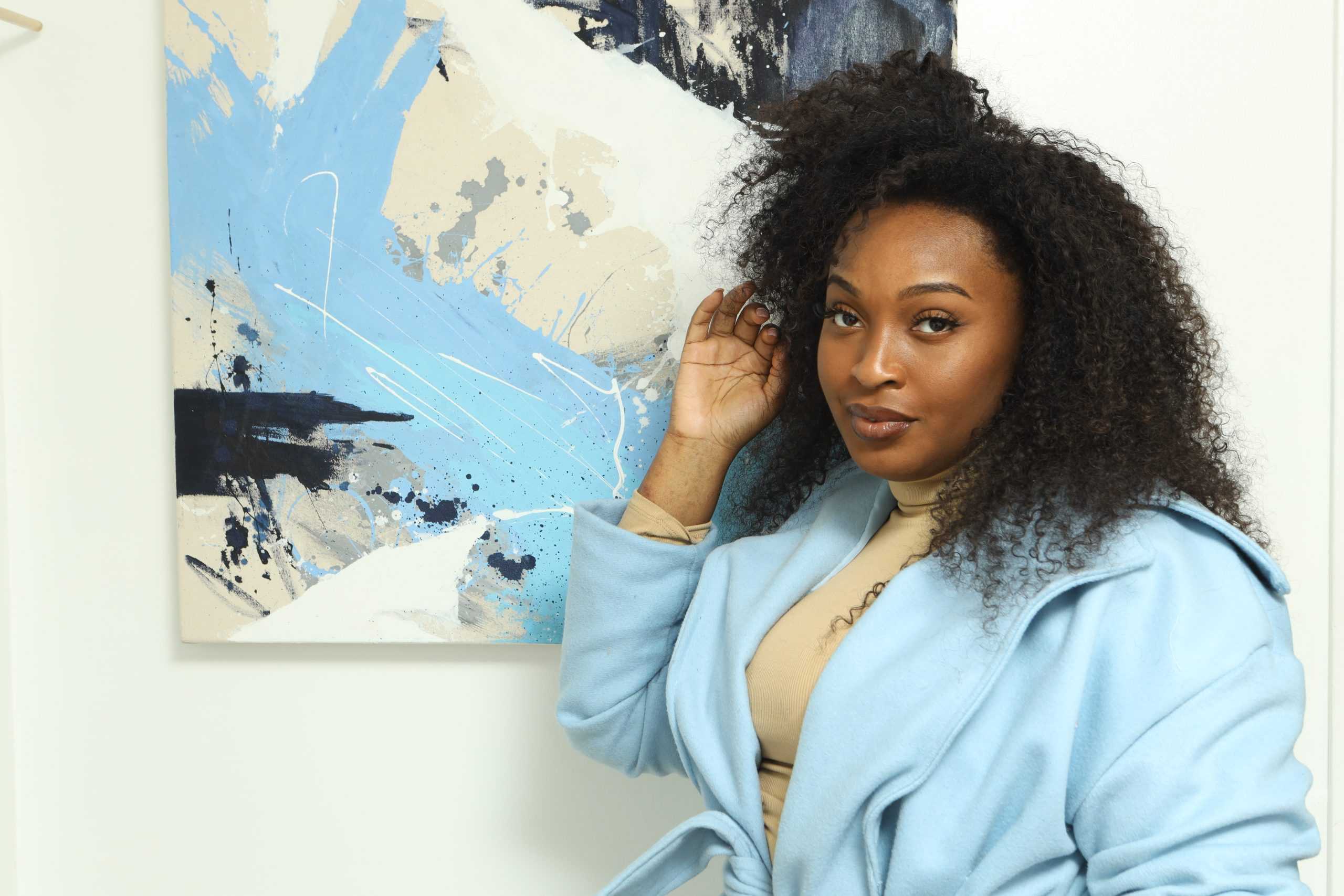
BY SIMONE J. SMITH
Whether it is photographs or works of art, images create a memory of people, places, and things that we hold with us forever. For Black women art has created a new space of recognition and has presented an opportunity to both celebrate and immortalize their contributions. It has created a new space of recognition.
Art does not show people what to do, or how to feel; great works of art create synergy between your senses, body, and mind. It can help you navigate your emotions, and this can spur thinking, engagement, and even action.
Most of us know the feeling of being moved by a work of art, whether it is: a song, a play, a poem, a novel, a painting, or a spatio-temporal experiment. Most recently I met a young woman, and upon seeing her work, I was transported to a new place that was, nevertheless, strongly rooted in a physical experience. I became aware of a feeling that I do not actively focus on. This transformative experience is what art is constantly seeking.
Quietly, Chika O has been experimenting with her artistic ability, finding ways to express herself, and help others express their innermost feelings. She specializes in curating inspirational and expressive paint events that enable those who are open to doing so tap into their creativity.
I was introduced to Chika O through a mutual friend of ours Nigel Birch; upon meeting her I knew that she was a phenomenon. It was on Friday, March 24th, 2023, that I saw the extent of her magic. She was the art curator at the LEGUP Secure your Wealth Symposium, and to see what she was able to do with the space, to turn a hotel common area into an art gallery; it was incredible. I decided right there and then that I wanted to share her talents with the world, so we sat down, and I went on an artistic journey with her.
“I went to school for the arts, but I didn’t do anything for myself,” Chika tells me. “I didn’t use my talent for anything. One day, I realized something had to change.
I was born in Mississauga, then my parents moved out to Newmarket. After my parents separated, myself, my four siblings, and my mother moved to Markham.
As a child, I was very vocal about what I wanted to do: be creative or play outside. All my gifts were focused on art. Give me paints, give me crayons, and give me a pencil crayon that is what I wanted. It was like this until I was 12 years old. School takes art seriously, so I used school as an outlet for my art.
They would spend more money on art supplies, and it allowed me to do more. There is basic art, but I wanted to be challenged. I wanted to learn techniques. From 10 to 12, that urge to learn more came up. My mom put me in art camp, and there I learned colour theory, sculpting, and how to work with clay.”
There was no denying; she was born an artist.
“I would win competitions at church because of the detail that I put into their work. There is so much that can be told by looking at a child’s art. You can learn so much from their world.”
She was very detailed explaining what art does for a child, and I knew that there was a story there.
“I was seven or eight when my parents separated. I learned a lot during that time. You never know what a child has to deal with. When I was younger, I was very attached to my dad. I copied everything he did. When my parents separated, the picture of my life was destroyed. When I had to shift to the new picture, I resented it. I didn’t like this new picture. Single mom, going to school, with the absence of my father; my world had revolved around him. I didn’t know what to revolve around anymore.
There was a gap, a hole. I woke up unhappy. Now I know that it was depression. My mom did the best she could. She would keep us connected to our community as much as possible, but it never filled the void.
It is only now that I am older; I realize why I focus on women in my art so much. It can be very difficult for us, especially when dealing with the opposite sex. Back then, I didn’t even have the words, so I put it in my art.”
Chika O takes her responsibility as an artist seriously; the idea that artists have responsibilities may come as a surprise to some – it is to help people not only get to know and understand something with their minds but also to feel it emotionally and physically. By doing this, art can mitigate the numbing effect created by our daily experiences. So, what she has done is find a way to bring art to the community in an interactive and engaging way.
“I curate events for organizations, and I also have fun with my paint nights. This gives me an opportunity to engage with individuals on another level. I want to inspire people to keep that creative muscle in their brains moving.
Art is what I do so that I do not self-inflict. How you process pain is unique for each person. When I am in my artistic space, I am reliving my pain, but in the way that heals me. When you don’t have the words to express how you feel, it can be really frustrating.
My paint nights are special to me. I am given complete creative control.”
Each month Chika holds a themed paint party; her next one is themed the Green Garden happening on Saturday, April 1st, 2023, from 7:30 PM 9:30 PM. Whether you are looking for a fun bonding activity for a group or a more personal experience, her events offer a perfect blend of social interaction and individual exploration. As your host, she is there every step of the way, guiding you towards creating a beautiful work of art that you can be proud of, and there is more…
I don’t want to give away too much about what Chika told me, but on May 6th, 2023, Toronto is going to be formally introduced to Chika O. A group of us will be working alongside Chika on a project that reflects the unique experiences of Black women. We will be fusing art and words to tell the story of a Black woman’s experience living in the diaspora. Her struggles, her joy, her pain, her celebrations; it will be a recognition of Black women all over the world.
“I have been working on things for a long time, and now is the right time to showcase what I have to the world. I am really excited about it, and what I will tell you is to start looking out for event details in the first week of April. For now, you can FOLLOW me on Instagram @paintwithchikaoh, or @artby.chikaoh.”
Women Empowered
Cassandra Geeta – Upholding justice and protecting the rights of individuals
Published
4 months agoon
December 19, 2023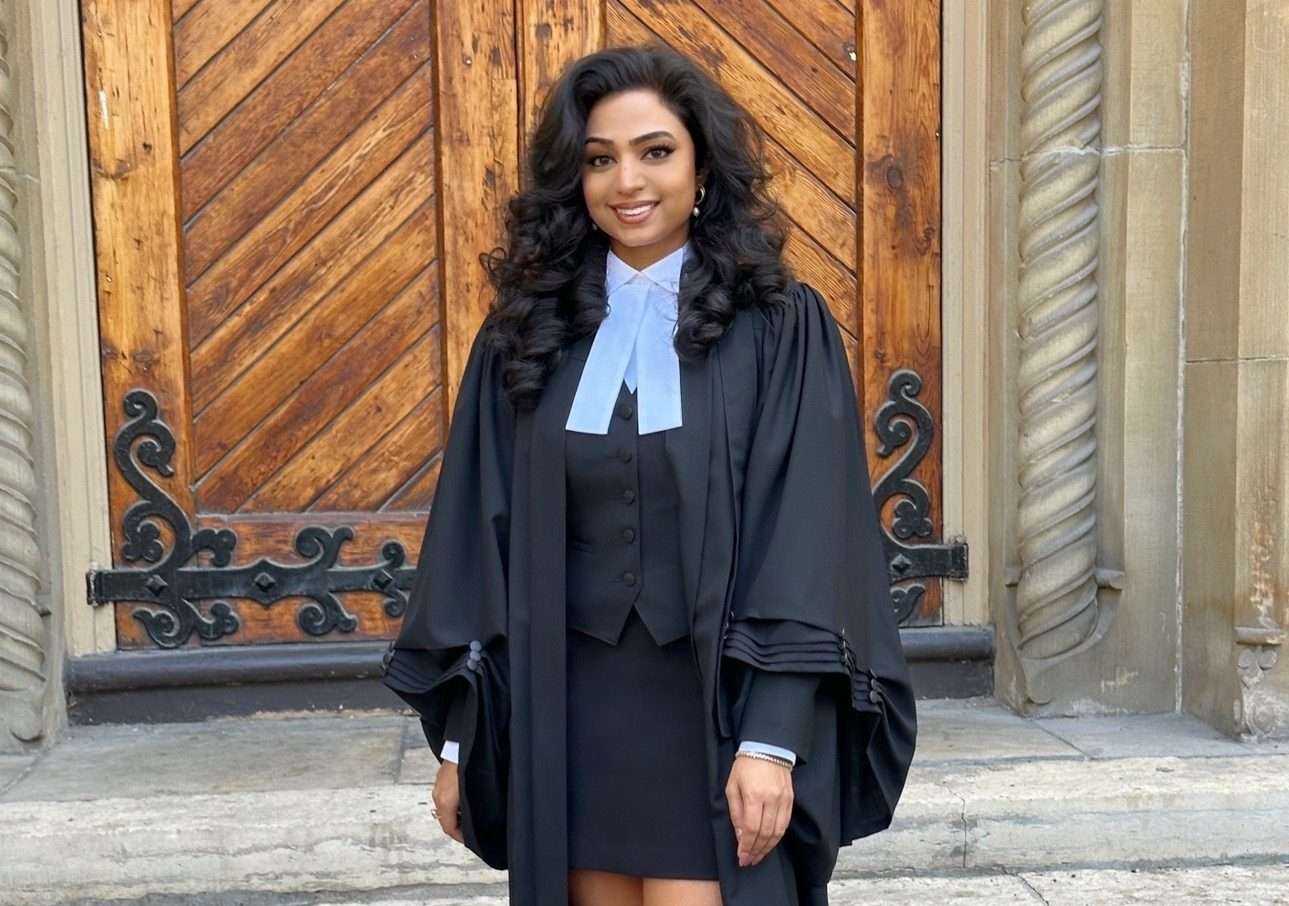
BY SIMONE J. SMITH
Women of colour have historically faced systemic barriers to entry and advancement in various professions, including the legal field. Discrimination, bias, and structural inequalities have limited their access to educational and professional opportunities.
The lack of women of colour in leadership positions within the legal industry has contributed to a cycle of underrepresentation. A lack of role models and mentors can make it more challenging for aspiring female professionals to envision a successful career in the field.
Luckily, our Woman Empowered smashed the ceiling on Tuesday, October 10th, 2023, by becoming one of the first Guyanese women to be called to the Ontario Bar.
She is a first generation Guyanese Canadian with roots in 58 villages of Berbice. Her mother emigrated from Guyana to the United States in the 70’s, before settling in Canada. She is an Associate Lawyer practicing exclusively in the area of criminal defense. She joined the team of Heller Hunter Azevedo after articling for a prestigious Toronto boutique criminal litigation firm. She has assisted with successfully representing clients at all levels of court in Ontario and Canada.
Prior to law school, our Woman Empowered graduated with distinction from the University of Toronto, where she obtained a double major in Criminology and Sociology, and Ethics, Society and Law. She also received her Masters of Arts from the University of Toronto in 2018.
She earned both a Canadian and an American Juris Doctor degree from the University of Windsor, and the University of Detroit Mercy in 2022. While in law school, she volunteered as a student attorney at the 36th District Court of Michigan’s Public Defender’s office and served as Co-President of the Windsor Chapter of the First-Generation Network. She was involved in the Criminal Law Association of Windsor, and Pro-Bono Students Canada, and was also the recipient of the 2021 Brian E. McIntyre, Q.C. Memorial Award in Criminal Justice.
It was such an honour to sit down with Cassandra Geeta, and dialogue about her journey to becoming a Criminal lawyer. What I learned is that this young woman is not only determined, relentless, and driven to represent her community the best way that she can.
“My mom immigrated from Guyana in her early teens, lived in the Bronx for a little, and then resided in Florida for a spell. Ultimately, she ended up in Canada. I was born in Brampton, Ontario, and we ended up settling in Mississauga. I had a difficult upbringing. When my mom moved to Canada, she moved because she had met my father. They ended up going through a difficult divorce, and my mom had no one here to support her. She was in a foreign land, facing a foreign justice system. All she had was her wits and courage to get through this.”
Thankfully, the universe sent them a guardian angel, a man named Vishnu Misir who was a lawyer from her mom’s extended family. “He helped my mom through some of her legal battles that she was fighting. He was one of the only family members who stood up for her and stood up for me. I can’t help but tell you that he has helped shape my destiny. He passed away a few years ago, and he didn’t get to see me where I am today. It is one of my biggest regrets to not get to see him now.
My mother and I are resilient. A lot of people don’t know what my mom and I have gotten through together. One aspect of my life that my mom enforced was school, ‘Take your education, take your book; when you have your education, no one can take it from you,’ she would tell me.
I started to take my education very seriously in high school, and I ended up at the University of Toronto. It was here in my third year that I was introduced to a Criminology course. Justice Davies taught that class. It was practical criminal work, and I thought I might be good at this.”
Her heart became set on criminal law, and she continued her education to get her Masters.
“I graduated in 2018, and things slowed down for a year. I had to take some time for myself. One of my first jobs was working at Mercedes Benz as a concierge, and all the while I was studying for school, and writing the LSAT.
My mom’s parents passed away four, or five years ago and it was devastating for the family. They were the eldest grandparents. These are two people: the matriarch and patriarch of our family, and they didn’t get to see me reach here.
When I received the acceptance at University of Windsor, I called my mom and burst into tears. Every day since then, it has seemed like one less burden was on my shoulders. I knew I was going to have a career; I wouldn’t be struggling anymore. I got into Law School, and I was determined. I have always viewed school as a great challenge, and if I put enough effort into it, I would be able to do well. I have always done well with school.
I applied to the Dual JD program. When my mom came to this country, she lost everything, but gained me. She stayed here because of me. Having an American law degree would allow me to take my mom back to where she would be happiest.
I didn’t feel intimidated, but I realized there was so much to learn. Law school solidified for me that Criminal Law was my path. My mom really wanted me to get into other types of law; I think that people think there is something seedy about criminal law.”
It is understandable why Cassandra’s mom was trying to steer her daughter in another direction. Criminal cases involve high stakes and can have a significant impact on individuals’ lives. The outcomes of cases may determine whether a person goes to jail, faces fines, or has their reputation tarnished.
The pressure to secure favorable outcomes for clients can be intense, and dealing with criminal cases can be emotionally draining. Criminal lawyers often work with clients who are facing serious charges and may be going through difficult circumstances. The emotional toll of handling such cases, especially those involving violent crimes or tragic events, can be challenging.
Cassandra knew that the legal system was complex, and that criminal lawyers must have a deep understanding of criminal law, court procedures, and legal precedents. She understood that building a successful criminal law practice would take time.
“My first year of law school was in person, and the second two years were virtual due to the pandemic. It was difficult; it felt like a long haul.
I became Co-President of the Windsor Chapter of the First-Generation Network. It was a student association geared towards First Generation legal professionals. People don’t understand how much work it takes, so to be able to connect with other students who understood the challenges was important.
I also served as Student Attorney at 36th District Court of Michigan. It was my first real stab at practical advocacy. It prepared me for my experiences after law school, especially when it came to engaging this vulnerable population.
What you take from your studies is different from person to person. Crime is not simplistic; it can be just one wrong decision along the road. I don’t judge my clients; when they turn to someone to help them, they don’t want to hear judgments on their actions. I am empathetic to them, and they need that.
My mom inspired me to be in service to people who might need help like she did. I want to be that helping hand to someone else. Everything is a reminder of where I came from.”
Despite these difficulties, Cassandra finds the work incredibly rewarding, as she now plays a crucial role in upholding justice and protecting the rights of individuals accused of crimes. The challenges in this field often come with the territory, and thankfully for our community, Cassandra is passionate about criminal law and justice. We are proud of you Cassandra; your work is needed.
Women Empowered
Amaya Athill Creating our space in the world of golf
Published
5 months agoon
November 30, 2023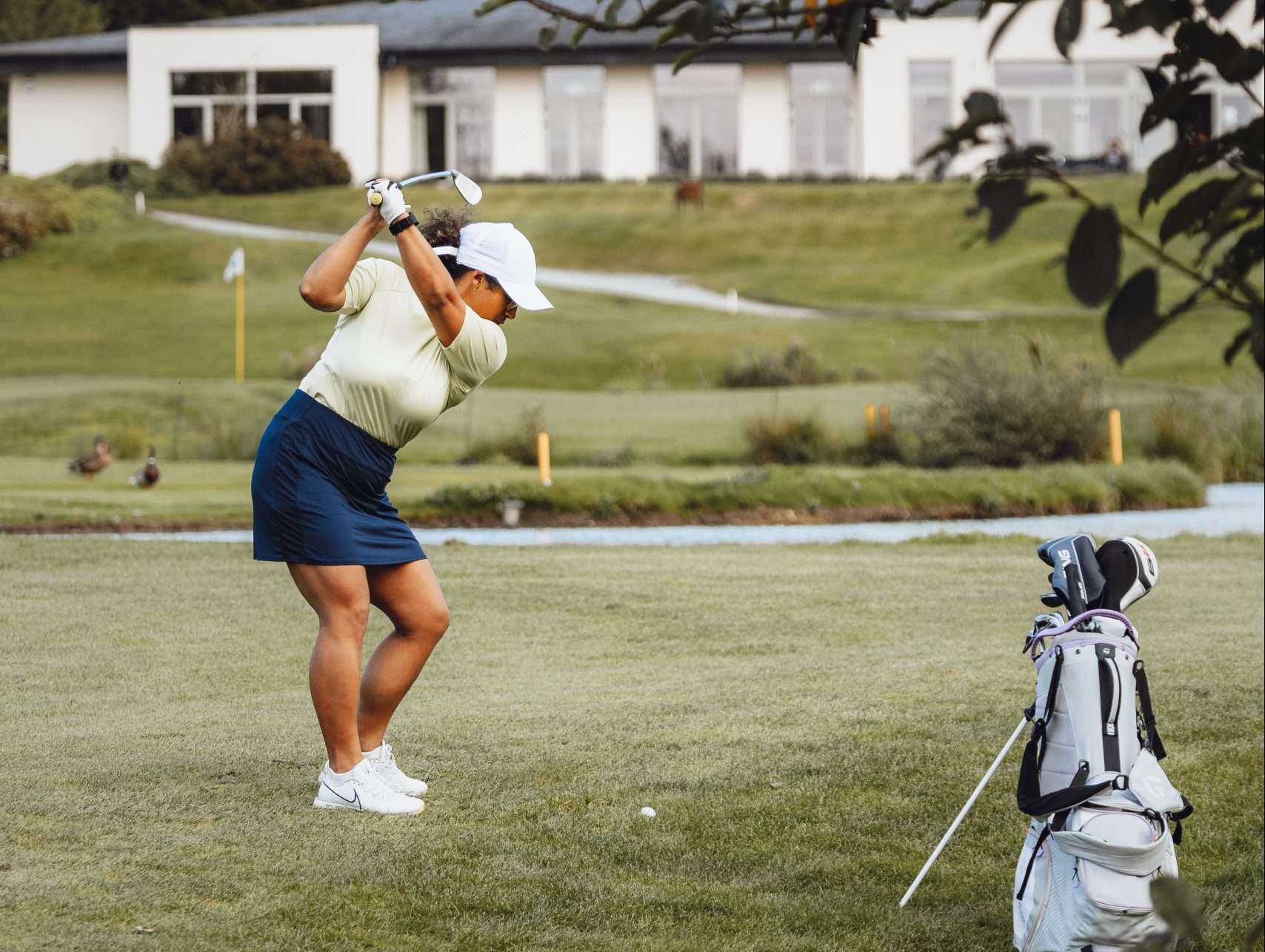
BY SIMONE J. SMITH
When you think about the game of golf, you think of it’s a game for White men. This is because the barrier of entry is high, and the techniques can typically only be sharpened with costly lessons over time. Although diversity within the sport is still questionable, more women are engaging in this activity and getting access to this secret world, and I am proud to say that one of our own is leading the pack.
Antiguan-born Canadian professional golfer Amaya Athill joined travel industry professionals for a day of fun on the links at this year’s Association of Canadian Travel Agencies (ACTA) Ontario Golf Tournament. On Thursday, July 13th, 2023, at Royal Ontario Golf Club in Milton.
With a 10-year background in law, our Woman Empowered is one of the few Black women to become a PGA professional in Canada. Since moving to Canada, a year ago, Athill has worked on a number of initiatives to make golf more inclusive. In her role as Manager, First Tee – Ontario with Golf Canada she works on creating opportunities for access to golf for children from historically underrepresented and marginalized communities.
She is a contributor for ScoreGolf Magazine where she highlights DEI initiatives in golf Canada-wide. She is also the founder of Black Women Golfers, whose mission is to ensure Black women – from beginners to more advanced golfers – have a space and community in the sport. I am going to share my interview with her, and I know you are going to find it inspiring.
When we choose our Woman Empowered features, we look for women who are not the norm, the ones who challenge societal thought, and pave their own trails regardless of what others think of them. They push boundaries, break glass ceilings, fail, recover, restart, and recalibrate. I couldn’t be prouder than to formally introduce to you our Woman Empowered, Amaya Athill.
“Before we even start Simone,” Amaya said excitedly. “I am a proud product of the golfing community in Antigua and pleased to represent my island in the golfing space in Canada. It’s an honor to have been invited by the Antigua and Barbuda Tourism Authority to support them in their mission to showcase all that Antigua and Barbuda has to offer to the travelling community. I really enjoyed myself.”
“So, Sis! You have to tell me how you got into golf. There is so much to your life resume, I am excited to hear it all. Where should we start?”
“Well, I was born and raised in Antigua, and I will admit. I travelled around a lot. I completed primary and high school in Antigua, and then went to the UK for University. At that time, my focus was school. I knew what I wanted to do, so I was determined. I started in law, 2011 and qualified as a barrister in the UK. I actually got to do six months of schooling in Jamaica and did the Antigua bar in 2012.
I got a Fulbright Scholarship to Georgetown University Centre in Washington D.C. and studied there for a while. I moved back to Antigua in 2013 and started a position at Lake & Kentish Attorneys at Law. Kenny Ketish was phenomenal. He mentored me in civil litigation and believe me it was very taxing. Working alongside Kenny was an incredible experience; I felt nurtured in my growth. I did a lot of human rights, and this was for six and a half years.
I got a fellowship opportunity for one year in 2017. Interestingly enough, it was in Montreal, Canada. The fellowship brought together 12 leaders, dumped us in a mansion, and we talked about politics, governance and excellence. It was a wonderful year, wonderful experience.”
Amaya’s travels did not stop there. She moved back to Antigua in the summer of 2018, and worked at the Legal Aid and Advice Centre from 2018 -2019. She then moved back to England and worked at the Commonwealth Secretariat working in international law.
“It was an in-house counsel role until 2022, and then I moved to Canada last year,” Amaya tells me.
“All right Amaya! Let’s get into the juicy parts; tell me all about your golf genesis.”
“I started playing golf when I was five years old. My dad introduced me to the game, and he put me in the junior golf academy. I was part of a very robust program. I met a lot of friends, and I really loved it. We were able to travel to compete in various golf tournaments across the Caribbean. When it came time to university, we did not have the tools needed to get scholarships, so I gave up golf for 10 years.
The pandemic hit when I was working in the UK. I was stuck in the apartment for a year. It was terrible, and my mental health took a hit, so I turned back to golf. I bought golf clubs off the rack, went to my local golf course and started playing golf again.
This time, it was different; in Antigua everyone looked like me in the golf industry, but in the UK, I was the only woman of color. I felt isolated and kinda intimidated. I had to question myself; why was I feeling like this? I connected with the African Caribbean Golf Association, and finally, once a month I had a community that I could golf with, play with, and I could network with.
I started to do a taster session (intro to golf session). Women would get to try golf, and I would offer a get into golf package where you would do six weeks with me to get into the sport. It was a really cool time; you can check out my Instagram page golf_interrupted. I started that in 2021.
I had applied for permanent residency after my experience in Montreal and was successful. During my process of moving to Canada, I was also in the process of applying (taking exams to transition my qualifications) for the bar in Canada.
“During that time, I applied for a manager position with First Tee-Ontario (Golf Canada). I saw this role and I thought, I am doing this already. I could do this as a side hustle. At that time, I was also kinda jaded when it came to my law career, so I contacted the director via LinkedIn. The message was very simple, ‘This is who I am. I am interested in this role, can we chat?’ He was very open to the idea and took a chance on me. I had a job to come to when I came to Canada, so I felt secure when my husband and I moved here last April.”
When she started her position, Amaya recognized a common theme. Once again, she was the only African Caribbean woman playing the sport.
“This is why I found the Canadian Caribbean Golf Association and started playing with them regularly. I spent the last year growing in my role. I love getting underrepresented children in the sport.”
Amaya was very transparent about her challenges. I have to say that I really appreciated that.
“I am a good golfer, not a great competitor. When you are competing, you can get in your head a lot. All of your flaws can show up on the golf course. It can break you down. When I decided to turn pro, I had to take a Playing Ability Test. You have to shoot below a certain score, and I failed miserably. Believe me when I say that it was a humbling experience.
During this experience, I noticed that every pro that there was to work with was either a white man, or a white woman. I took the test again in May and passed. I am one of the few African-Caribbean women who is in the PGA. I also passed the bar in June.”
“Oh gosh! Congratulations Amaya! That is a lot that you accomplished in a short amount of time.”
“Thank you so much Simone. What I am really proud of is doing more for the sport by founding Black Women Golfers. We started meeting up in the off season and practiced golf together. My question was, how do we get more women in the sport?
We had an intro to golf session where 18 women came and were taught the basics of golf. Then there is a range meet up once a month and we practice together. Then once a month we have actual games. It is very new, we just started. We partnered with Brown Girl Outside World on this initiative; golf has been added to their calendar.”
What a sensational woman; she is everything that we want for our Women Empowered Feature. Amaya, keep being a light in this dark world.

Step into Spring with SheaMoisture’s new collection

The cost of convenience: how much does delivery really cost?

Will Léonice Huet (Black badminton player) qualify for the Paris 2024 Olympics

Beneath the waves: Unveiling the legacy of the transatlantic slave trade in the Bahamas

Everlasting Flames-to be Submitted

Amplifying authentic African narratives; the stars came out at the BSO Symposium
YOGA: Surya Namaskar (Sun Salutation) for sufferers of hypertension or heart disease
Kemtek Development launches new exclusive gated community in Jamaica!

Ravi’s West Indian Grocery – Fresh Products Weekly Straight from Guyana!

Tourism-Related Live Streaming – The Manifold Ways it Can Create a Buzz for a Destination

ASA Meats & West Indian Groceries – Serving Freshness & Quality to the Community

Do You Have a 407 ETR Story?

Nadine Sutherland – A woman who continues to reinvent herself

Knia Singh – Light Up The Darkness

Spragga Benz – Light Up The Darkness

Kyle Kemper – Light Up The Darkness

David Icke – Light Up The Darkness

Ohio’s Bill 248 and Dr. Sherri Tenpenny’s compelling testimony
Trending
-

 Community News2 weeks ago
Community News2 weeks agoAlmost Homeless – Eight years of Justin Trudeau; Canada’s housing is against the ropes, and Toronto renters suffer
-

 Community News1 week ago
Community News1 week agoChemical hair straighteners are causing uterine cancer, fibroid tumors and infertility in women of colour
-

 Community News1 week ago
Community News1 week ago“Stop egging me on!” Companies are simply getting better at carefully wording things on their packaging
-

 Community News1 week ago
Community News1 week agoRichard Rooney gifts $5 million to the African Studies Centre and the Centre for Caribbean Studies at the University of Toronto
-

 Community News2 weeks ago
Community News2 weeks agoFreedom Mas Kick off the start of Band Launch Season 2024
-

 Community News1 week ago
Community News1 week agoNot just a reunion; It’s a powerful catalyst for unity and growth. Welcome to the 10thBiennial Jamaica Diaspora Conference
-
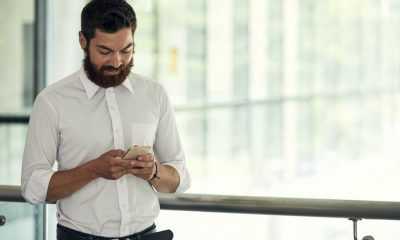
 Community News2 weeks ago
Community News2 weeks ago14 Days to a healthier work-life balance
-

 Community News1 week ago
Community News1 week agoSharp rise in the number of medically assisted deaths in Canada sparks concerns





